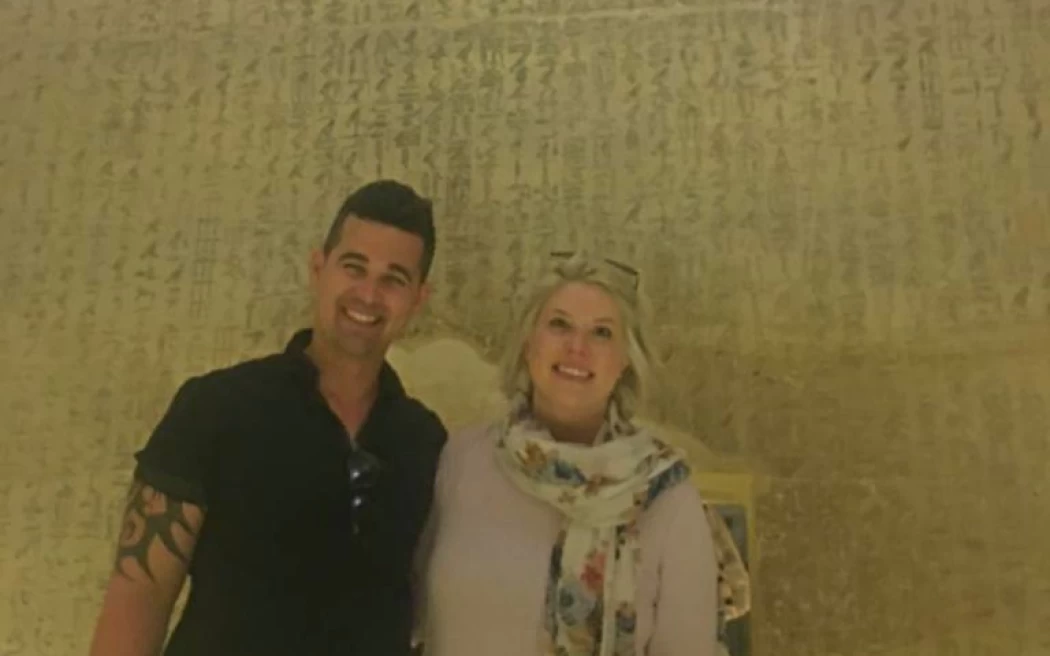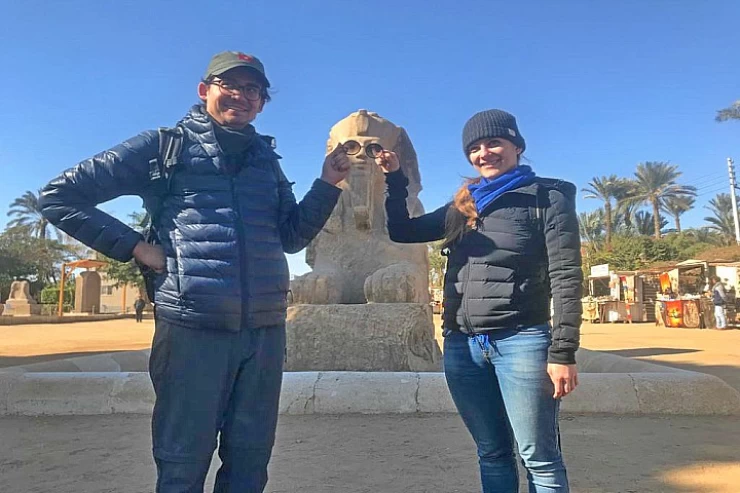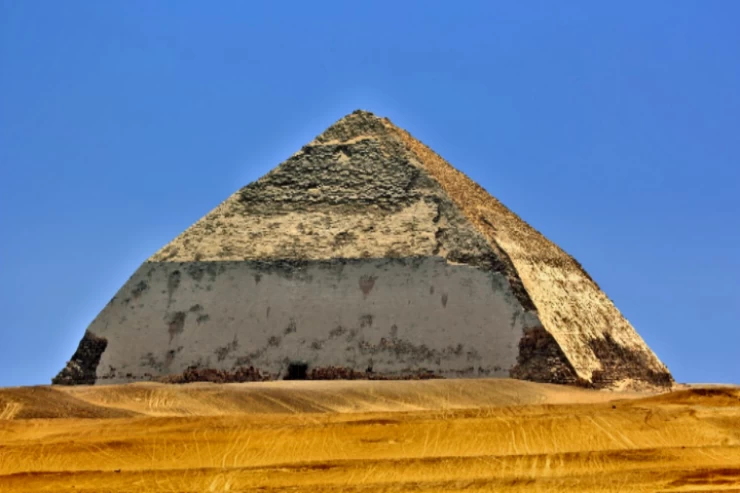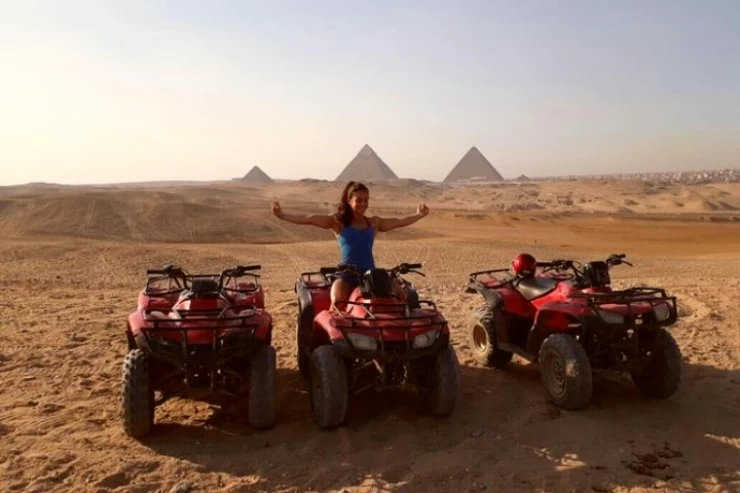
Pyramid of Teti History
The Pyramid of Teti in Saqqara near Giza was built by Pharaoh Teti, founder of the Sixth Dynasty. Teti ruled Egypt after Pharaoh Unas, who was the last king of the Fifth Dynasty. We also know that Ounas built a pyramid for himself in Saqqara, near the pyramid of Djoser, and the texts of the pyramids were engraved on its inner walls, which give us a picture of the ancient Egyptians’ perception of the other world and the journey of the deceased pharaoh in it.
The structure of the Teti pyramid was similar to the complete pyramids built in the late Old Kingdom during the fourth Egyptian dynasty, headed by the Great Pyramid, and the height of the original Teti pyramid was about 52 meters, and it is similar to the pyramid of Pepi I and the pyramid of Pepi II. The heart of the Teti pyramid consists of five terraces of sandstones from neighboring quarries . The exterior of the pyramid was covered with white limestone of unknown origin; it is known that the covering of the pyramids of Giza came from quarries on the East Bank of the Nile from the Tora quarries in Helwan.
The base of the pyramid of Teti has a rib of 78.8 meters and the slope of the pyramid was 53° 7' accordingly, the original height of the pyramid was about 52 meters .
The entrance to the pyramid is located at ground level on the north side of the pyramid and leads to an inclined vestibule . The inclined vestibule is followed by a horizontal vestibule equipped with obstacles and leads to a system of Chambers; the system of Chambers consists of a front chamber, a coffin chamber, a secondary chamber followed by three small chambers as vaults . The sarcophagus chamber reaches an area of 3,45 × 7,90 meters and is located below the center of the pyramid about 17 meters below ground level.
The roof of the sarcophagus chamber consists of three tiers of large ribbed stones distributed on two sides above the chamber, formed in the form of a gable. The sarcophagus is located in the western part of the chamber and is made of stone and inscribed with funerary hieroglyphic phrases . Hieroglyphic phrases from the texts of the pyramids are also inscribed on the walls of the sarcophagus chamber and the front chamber.
On the eastern side of the pyramid of Teti there is a funerary temple, of which little has survived due to the use of its stones in other buildings in Cairo . A small pyramid of worship is located on the south-eastern side of the pyramid . It was a large wall that surrounded the Teti pyramid, the small pyramid and the funerary temple .
On the north-eastern side of the complex are the remains of two small pyramids of the Queens ebut I and "Shwet" . A third small pyramid was also discovered in 2008, most likely that it belonged to Teti's mother, Queen sichiskhet .
The area around the Titi pyramid complex developed over time and became a large necropolis with many ancient Egyptian tombs . Among them are chapels for the ministers of mereruka, kahmani and gimni imhatat, as well as the tiatiti cemetery .
The Ptolemies and Romans also built the temples of anubion and bubastion to sanctify the machine of the ancient Egyptians Anub and Bastet on the eastern side of the pyramid of Teti.
Saqqara necropolis houses the Teti pyramid, which is one of the most interesting pyramids in decreasing order of age and significance. This pyramid was built for Pharaoh Teti, the first king of the Sixth Dynasty of ancient Egypt, approximately between 2345 and 2333 B.C. In this manner, this structure is an integral part of Ancient Egypt's elaborate royal tomb architecture. The small Teti Pyramid, which may not be as famous as the Great Pyramids at Giza, to this day remains significant because of the Pyramid Texts found inside the Teti Pyramid walls that show what ancient Egyptians believed about religion.
Like other interesting structures, such as the Step Pyramid of Djoser, the Teti Pyramid is located in the Saqqara area. Being, on the outer surface, a small pyramid able to lie behind the monuments, the Teti pyramid radiates considerable spiritual strength and architectural upheavals, which are very fascinating to people in the history of Egypt. That is why this pyramid is affordable for the tourists.
Pharaoh Teti was the first of the Tenth Dynasty rulers of Egypt who built its pyramids. This period marked the end of the apex of the pyramid building of the Old Kingdom’s Fifth Dynasty at the Western Desert and the onset of widespread political and economic troubles. Even during the reign of Teti, who ascended the throne in the flourishing civilization of Egypt, it was a great and rich country of the first order. However, the signs of conflict within the state’s system, which had previously been quite solid and centralized, began to emerge, laying the groundwork for future conflicts within the power depicted so firmly.
Teti came to power after King Unas, the last king of the Fifth Dynasty, completed his reign. He also respected the traditions of the great eras and the pyramid-building culture.
In about twelve years of power only, despite his short rule, Teti's pyramid at Saqqara with its mortuary complex points to his wish somehow to transcend the mortal realm and continue with the veneration of the primitive deities of Egypt. The pyramid is also of great importance when one considers the religious practices of Egypt during the Old Kingdom, owing to Teti's tomb containing Pyramid Texts, which survive to this day as a part of funerary customs in Egypt.
The Pyramid of Teti was once a large structure with a smooth casing of white limestone that made it glisten under the hot desert sun. However, the outer surface of the pyramid has suffered over the years and is now broken. In contrast, the inner grounds have remained relatively intact, thereby maintaining the inner significance of the essence of the pyramid.
With a height of 52 meters (170 feet) and a base measuring 78.5 meters (258 feet) on each side, the Pyramid of Teti is relatively small when compared to the other great pyramids of Giza. However, the most interesting part of the pyramid remains concealed. Its smooth-sided form was already observed as an architectural gesture that evolved from the previous pyramid constructions of the Old Kingdom. However, innovations were within the structure. Particularly, the sacred images and religious texts that were decorated on the walls of the interior parts of the pyramid were new.
Teti's pyramid, like the other royal pyramids of its time, was also built with a mortuary temple and a connected causeway leading to the Valley temple at the bank of the Nile. The causeway functioned both as a ceremonial track for the departed monarch in his traversal to the world beyond and as a path for priests and congregants during burial services. Most of the structure is in ruins today, but its design has shaped the traditions associated with the construction of pyramids in Egypt.
The Pyramid of Teti displays one exceptional characteristic of importance: her Pyramid Texts on the walls of the burial chambers, which are among the earliest known inscriptions of a religious nature. They record detailed prayers, hymns, and spells that contributed towards enabling the pharaoh to inhabit the other world, and they are the most ancient known religious inscriptions in existence.
The texts served the purpose of shielding and assisting the soul of the king in such a way that he is ensured of resurrection and eternal presence with the gods. They contain ways in which the king could rise to the heavens, mention of Ra the sun god, and Osiris the god of the underworld, and prayers to other gods for safety. These religious writings can be considered precursors to the more elaborate, long-written funerary inscriptions that came later on, such as the Coffin Texts and the Book of the Dead during the Middle Kingdom and the New Kingdom.
These writings are of great importance even for present-day archaeologists and historians as they illustrate the religious tenets of ancient people like the Egyptians. The Pyramid Texts in Teti's pyramid are more or less the same as those in the pyramid of his predecessor Unas, suggesting a consistency in the burial practices throughout the dynasties.
The Interior Chambers: A Sacred Journey
Visitors to the Pyramid of Teti can plunge within the structure's interior and see the chambers that housed the urn of the long-dead pharaoh. First, however, visitors must crawl through a dark, narrow, sloping passage that leads to several rooms built to keep the king’s corpse safe and to the spirit’s way to the other world.
What first meets the eye of the visitors who enter the burial chamber is a large stone sarcophagus, which is believed to have contained the body of Teti and which has been placed in the center of the chamber. Even though the design of the sarcophagus is more or less plain, its massive scale and location in the room indicate the importance of the pharaoh’s final resting place.
The Pyramid Texts, which consist of hieroglyphs that are grossly incised on the limestone walls encasing the tomb, line the sides of the burial cell. They are clear poetic and devotional stories that reflect the ancient concepts of the Egyptians and their faith in immortality.
Saqqara Necropolis: Teti’s Pyramid in the Land of the Dead
Тети’s Pyramid is situated in the expansive necropolis of the Saqqara, which was used as a burial ground for thousands of years for the rulers and elites of ancient Egypt. This ancient cemetery in Saqqara is best known for the Step Pyramid of King Djoser, the first man-made monumental structure in the world constructed solely of stone. However, it is far from its only wonder, for it holds countless tombs and pyramids, which show how the ancient Egyptians’ methods of burying their dead progressed throughout the years.
Tombs of the high officials and nobles who served Pharaoh Teti can also be found near the Teti Pyramid for all visitors to experience. The Tomb of Mereruka is one of the most famous and is a beautifully adorned tomb of one of Teti’s viziers. Mereruka’s tomb includes many reliefs showing aspects of daily, rustic, and ritual life that help understand the Old Kingdom in Egypt.
The Saqqara necropolis continues to be a major site for archaeological discovery, with new tombs and artifacts uncovered regularly, shedding light on Egypt’s ancient past.


















